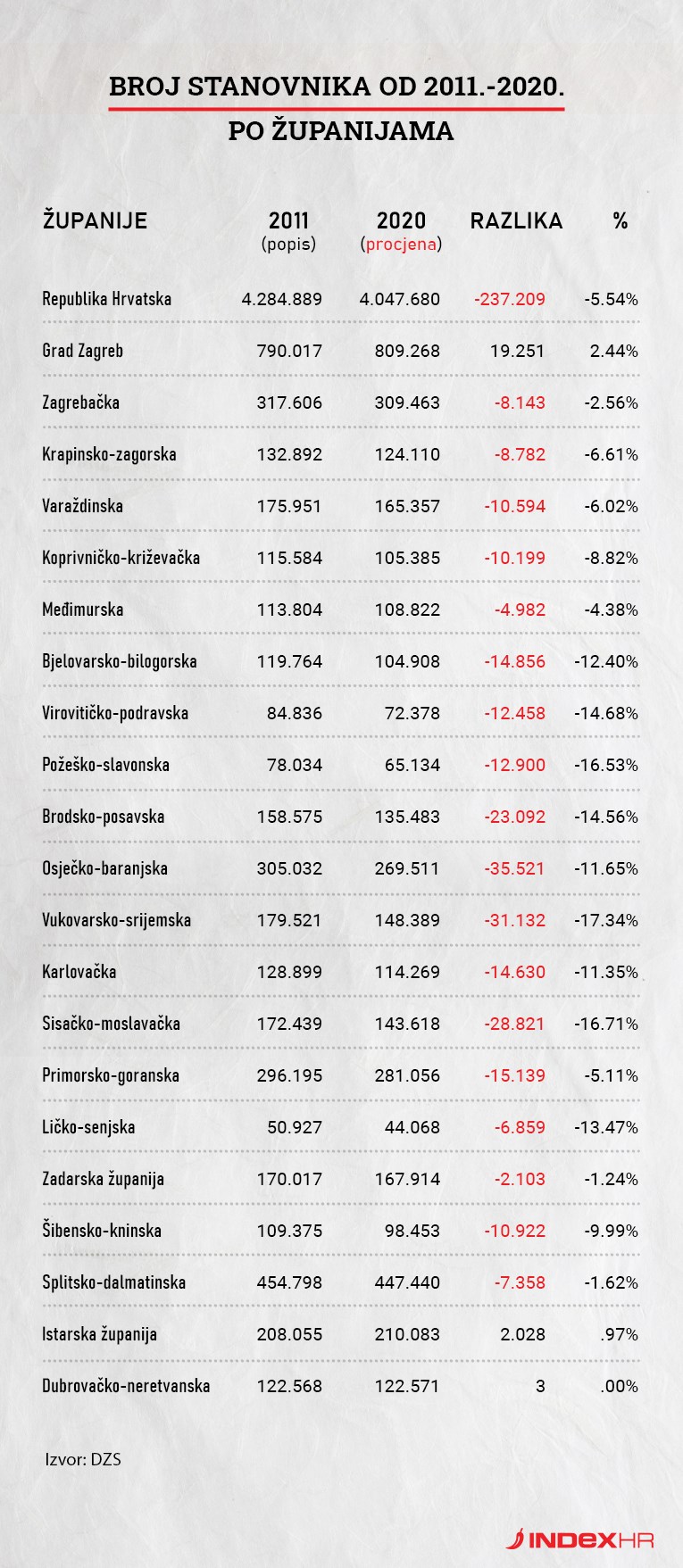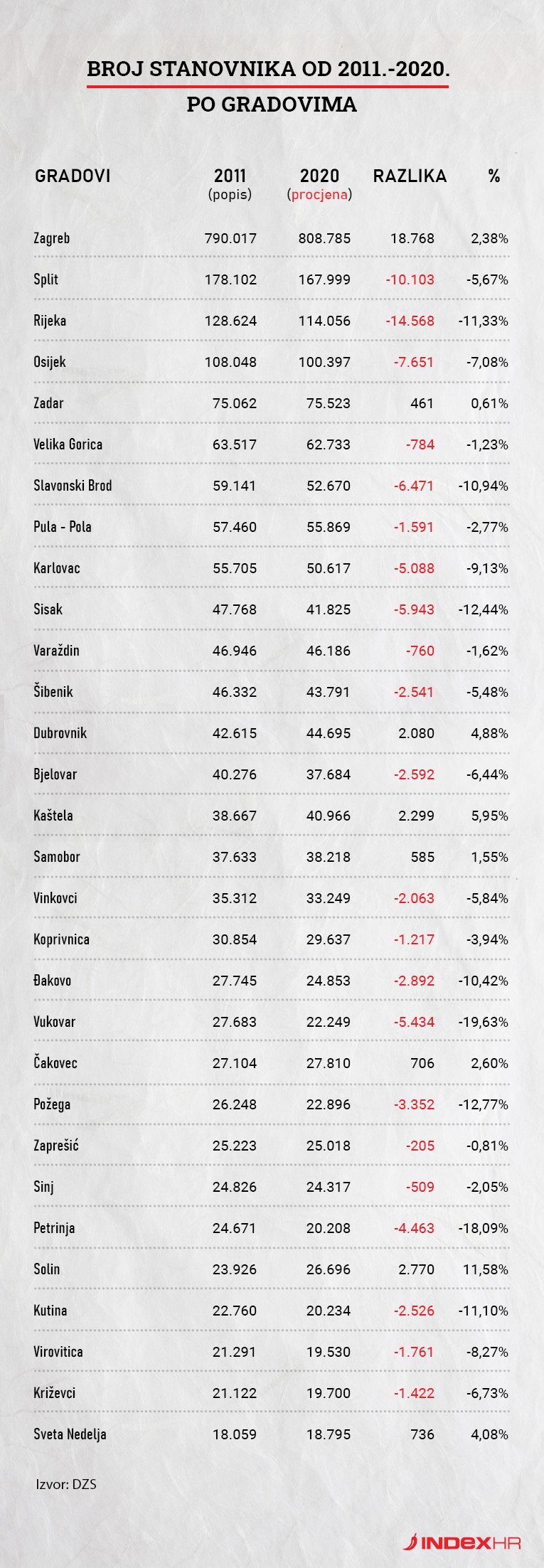Croatia Has 237,000 Fewer Inhabitants than 2011: Breakdown by City and County
October 25, 2021 - The Central Bureau of Statistics has published an estimate of the number of inhabitants by cities, municipalities and counties at the end of 2020. An estimate which says that Croatia has 237,000 fewer inhabitants than 2011, reports Index.hr.
According to the CBS, at the end of 2020 Croatia had about four million and 48 thousand inhabitants, which is about 237 thousand less than in the last census in 2011.
Only three counties have an increase
In ten years, Croatia has lost about five percent of its population. In other words, it lost every twentieth inhabitant.
Only three counties have seen population growth since the last 2011 census. This is the City of Zagreb, where a little more than 19,000 more people live compared to ten years ago, while Istria and Dubrovnik-Neretva also recorded an increase, but almost insignificant. In Istria, the population increased by slightly more than two thousand, while in Dubrovnik-Neretva it increased by about three people.
Eastern Croatia hardest hit
Eastern Croatia suffered the greatest losses. Overall, Osijek-Baranja County lost the most, with 35,521 fewer people now than in the previous census, while Vukovar-Srijem County experienced the biggest drop in population, losing more than 17 percent of its population.
Among the counties with higher losses are Sisak-Moslavina (-16.7 percent) and Požega-Slavonia (-16.5).

Rijeka lost the most people, looking around the cities
Depopulation has affected cities on the Adriatic coast.
Rijeka lost the most because it lost more than 14,500 inhabitants in the period under review. It is followed by Split with a deficit of about 10 thousand inhabitants and Osijek, which has 7650 people less than 10 years ago.
Looking at the relative picture, the biggest losers are cities from eastern Croatia. Vukovar leads with a lost fifth of the population. Among the biggest losers are three other Slavonian cities - Požega, Slavonski Brod and Đakovo.
The largest cities in Sisak-Moslavina County were also affected. Petrinja lost just over 18 percent of its population, while Sisak and Kutina lost more than 10 percent.

Solin, Kaštela, Dubrovnik and Sveta Nedelja have the highest relative growth
The largest relative increase in the number of inhabitants among the 30 largest cities was recorded in Solin (+11.6 percent), and a significant jump was achieved by Kaštela (+5.95), Dubrovnik (+4.88) and Sveta Nedelja (+4.08 percent).
We will see the true demographic picture of Croatia at the end of this year, when the results of the current 2021 census are expected.
How does the CBS calculate the population estimate?
The CBS has published on its official website the methodology for calculating the population estimate.
"Sources of data for estimating the population of the Republic of Croatia are the following surveys: Census of population, households and dwellings 2011, statistics of births, statistics of deaths, statistics of internal migration of the population, statistics of external migration of the population.
Population estimates include all persons included in the total population of the Republic of Croatia by the 2011 Census of Population, Households and Dwellings, all persons born and registered in the State Register of Births in the period from 1 April 2011 to the date of the estimate, all persons who died and were registered in the State Register of Deaths in the period from 1 April 2011 to the date of assessment and all persons who moved from abroad or emigrated abroad as well as persons who moved within the Republic of Croatia in the period from 1 April 2011 until the date of the assessment, " the explanation reads.
Census Kicks Off Under Slogan "Together We Create a Picture of Croatia"
ZAGREB, 13 Sept 2021 - The census of population, households, and dwellings in Croatia, conducted under the slogan "Together We Create a Picture of Croatia", will last from today, 13 September, until 17 October, and for the first time, it will be implemented in two stages, the first of which will be digital.
The census is the most comprehensive statistical survey and covers three elements -- population, households, and dwellings. In the first stage, until 26 September, citizens will be able to self-enumerate via the e-citizens system.
In the second phase, from 27 September to 17 October, census takers, that is the field staff, will conduct face-to-face interviews with citizens and register, with the help of electronic devices, all census units that have not self-enumerated.
In the first phase, citizens will be able to fill in a questionnaire of about 60 questions to register themselves and the members of their household.
The self-enumeration rule is that if more than one member of a household uses the e-citizens system, only one member enters data on other members of the household, the household itself, and the dwelling.
The reference time of the census will be midnight 31 August 2021.
A total of about 9,500 persons will be engaged in the implementation of the census, including about 8,000 census-takers, 1,100 controllers, 170 instructors, and 45 coordinators, as well as members of county census committees, branches, and census centers.
The census refers to Croatian nationals, foreign nationals, and persons without citizenship who have permanent residence in Croatia and persons who at the reference time of the census reside in Croatia.
The first results will be published no later than 60 days after the end of the census, and the final results will be published according to the publishing program and calendar of statistical data issues of the Croatian Bureau of Statistics (DZS).
The DZS will conduct the census in compliance with the recommendations of the national COVID-19 crisis management team, given the coronavirus epidemic.
For more, make sure to check out our dedicated lifestyle section.
Croatian Census in Two Weeks, Fines for Those Who Refuse to Partake
September the 3rd, 2021 - The Croatian census is due to be carried out in two weeks, and every single resident of Croatia needs to partake. If you refuse to do so, a fine of between 2,000 and 5,000 kuna could be issued to you.
As Poslovni Dnevnik writes, every inhabitant single legal resident of the Republic of Croatia is subject to the Croatian Census Act, according to which every person who refuses to be enumerated faces a fine of two to five thousand kuna.
Lidija Brkovic, the director of the Central Bureau of Statistics (CBS), spoke for local portal Glas Slavonije about the Croatian census, which is set to begin in two weeks following a coronavirus-induced delay earlier on in the year.
"The Croatian census is based on an individual statement, and the enumerator has no right to ask for documents or check the answers that a person gives. Every resident of Croatia is subject to is the Act on the Census of Population, Households and Dwellings in the Republic of Croatia in 2021, which provides for the issuing of fines from 2,000 to 5,000 kuna for a misdemeanor of a natural person if they refuse to provide their data for the census. People can have full confidence in the Central Bureau of Statistics because all the data collected by the Bureau remains an official secret,'' assured Brkovic.
Two phases of the 2021 Croatian census - online and offline
The Croatian census will be conducted in two phases - the first will be a ''self-census'' of residents online through the e-Citizens (e-Gradjani) system, followed by a field census of those who didn't register online. The fieldwork begins on September the 27th and will run through until October the 17th, 2021.
“The first phase of self-enumeration through the e-Citizens system will last from September the 13th to the 26th, and just one person in the household who uses the system is enough and will be able to enumerate all members of their household. If more than one household member uses the e-Citizens system, it still must only be one person listing all of the household members,'' said Brkovic.
For more, follow our lifestyle section.
President Warns about Depopulation Crisis
ZAGREB, November 10, 2018 - Attending a special session of the Vukovar-Srijem County Assembly in the eastern town of Ilok on Friday, President Kolinda Grabar-Kitarović said that over the past few years Croatia had lost twenty times more people due to depopulation crisis than it had in the 1991-95 Homeland War.
Addressing the assembly, Grabar-Kitarović called for the prosecution of war crimes, underscoring that it needed to be kept in mind that responsibility for a crime was personal and an individual's guilt must not be the cause for collective stigmatisation. "We have achieved progress in co-existence after reintegration and we have to continue building it, not just at the level of political rights, but primarily by building human relations and ensuring prosperity for everyone," she said.
The president added that these are important issues for the future, which is "threatened by depopulation." Croatia has lost at least twenty times more people due to depopulation than it did in the Homeland War, she said.
The president welcomed measures to amend the Citizenship Act which will facilitate obtaining citizenship for Croatian descendants born abroad, and added that it was necessary to create conditions for immigration from other countries as well.
She commended the Slavonia, Baranja and Srijem project and called for financial decentralisation and strengthening the role of counties in the absorption of EU funds. In a message to young people, she called on them to not give up on their ideals and to be resolute in building successful personal and business lives.
Regional Development and EU Funds Minister Gabrijela Žalac said that there was no more time for regret at the missed opportunities in Croatia's economic revival. She reiterated that so far projects valued at 2.3 billion kuna had been contracted for Vukovar-Srijem County alone, as part of the Slavonia, Baranja and Srijem project.
For more on Croatia's demographic crisis, click here.
Who is Leaving Croatia and Who is Coming? Official Migration Statistics 2007-16
January 27, 2018 - An overview of the trends of migration to and from Croatia over the last decade, according to official statistics.
How Does Croatia Respond to a Rare Mini-Baby Boom in Jastrebarsko? Ajme Meni
How do the Croatian authorities respond to a rare population good news story, at a time of declining birthrates and mass emigration? Like this, according to one of the local residents partially responsible for the boom, according to entrepreneur Davorin Stetner's Facebook post on December 4, 2017.
Croatians Leave Home Latest in EU, and Getting Later
When do the kids finally leave home? Not for quite a few years in the case of Croatia, reports Euronews on May 6, 2017.
Demographic Catastrophe Threatening Croatia
Croatia is losing population at a worrying rate.
Croatian Population Decline Continues: Lowest Birthrate for 25 Years
Croatia's worrying population decline is continuing, according to official statistics released on July 22, 2016.
As Slavonia Empties, a Canadian Osijek Resident Highlights the Positives
There has been plenty of reaction to yesterday's article on the depopulation of Slavonia, as the region's youth heads to Germany in search of a better life. One man heading in the opposite direction is Canadian resident of Osijek, James B. Macdonald, who balances the bleak overall situation with a string of positives about Osijek and Slavonia on May 22, 2016.


